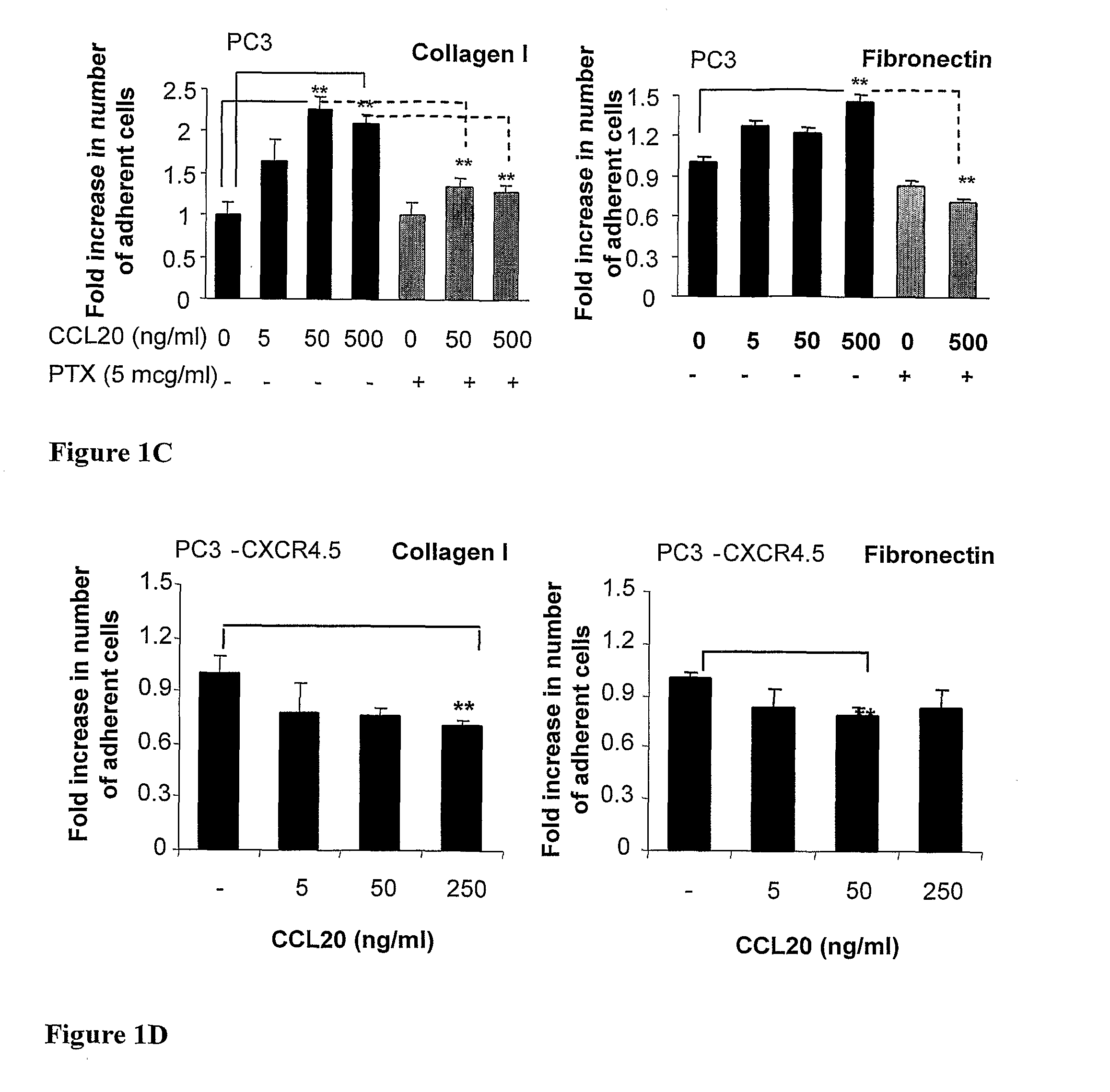Ccl20-specific antibodies for cancer therapy
a cancer and ccl20 technology, applied in the field of cancer therapy, can solve the problems of inconclusive and contradictory cumulative data, and achieve the effects of reducing tumor size, enhancing tumor regression, and inhibiting or reducing tumor progression
- Summary
- Abstract
- Description
- Claims
- Application Information
AI Technical Summary
Benefits of technology
Problems solved by technology
Method used
Image
Examples
example 1
CCL20 Promotes the Growth and Adhesion of CCR6-Expressing Tumor Cells In Vitro
[0150]To investigate the role of CCL20 in prostate cancer development, the expression of CCL20 and its receptor CCR6 was characterized in human prostate cell lines PC3, LNCaP, 22RV1 and DU145. First, CCR6 receptor surface and mRNA expression levels was examined in these four cell lines. RT-PCR analysis and FACS analysis demonstrated that only PC3 cell line expressed CCR6 receptor on mRNA level and on the cell surface (FIG. 1A). Next, ELISA experiments were performed to determine the secretion levels of CCL20 chemokine. Among the four prostate cancer cell lines studied only PC3 cells secreted detectable levels of CCL20 into the culture supernatant during the 48 hours incubation. However, in addition to PC3 cells, the mRNA expression of CCL20 was demonstrable in DU145 cells and at a very low level also in LANCaP cells.
[0151]To assess biological behavior resulting from CCL20-mediated activation in PC3 cells, ...
example 2
Overexpression of CCL20 Increases the Growth, Invasion and Vascularization of PC3 Prostate Cells In Vivo
[0160]To determine the role of CCL20 in tumor development in vivo, a tumor xenograft model was used. Human mock-transfected and CCL20-overexpressing PC3 cells were injected subcutaneously into SCID / bg mice. For in vivo experiments PC3-CCL20 clones 10 and 30 were chosen, since these clones demonstrated increased proliferation rate in culture, and produced either comparable levels of CCL20 (100, and 320 pg / ml) to PC3-CXCR4.5. Mice injected with PC3-CCL20.30 cells developed larger tumors as measured by increase in size comparing to mice injected with mock-transfected PC3 cells (FIG. 3A). Moreover, tumors produced by PC3-CCL20.30 cells were more vascularized and invasive to the neighboring tissues (muscle and dermis) (FIG. 3B). These findings were confirmed by H&E-stained tissue sections of xenograft tumors. Histological analysis of PC-CCL20 tumors demonstrated the invasion of tumors ...
example 3
Neutralization of CCL20 Inhibits the CCL20 and CXCR4-Dependent Growth of Prostate Tumors
[0162]Having established the role of CCL20 in cancer development in vivo, the effect of neutralizing antibodies to human CCL20 on the growth of CCL20-and CXCR4 overexpressing PC3 cells was evaluated. First, the ability of anti-CCL20 antibodies to neutralize the CCL20-induced adhesion in vitro of PC3-CCL20.30 cells to collagen I was tested. The presence of monoclonal anti-human CCL20 antibodies abolished the adhesion of PC3-CCL20.30 cells to collagen I in response to CCL20 stimulation (FIG. 3D).
[0163]Next, the in vivo potential of neutralizing anti-CCL20 antibodies was assessed. PC3-CCL20.30 cells were injected subcutaneously into SCID / bg mice. Twenty-four hours after the cell injection mice started to get treatment with subcutaneous injections of anti-human CCL20 antibody or isotype control, 20 μg of antibody per injection, three times a week, during four weeks. Significant decrease in tumor grow...
PUM
| Property | Measurement | Unit |
|---|---|---|
| Composition | aaaaa | aaaaa |
| Vascularization | aaaaa | aaaaa |
Abstract
Description
Claims
Application Information
 Login to View More
Login to View More - R&D
- Intellectual Property
- Life Sciences
- Materials
- Tech Scout
- Unparalleled Data Quality
- Higher Quality Content
- 60% Fewer Hallucinations
Browse by: Latest US Patents, China's latest patents, Technical Efficacy Thesaurus, Application Domain, Technology Topic, Popular Technical Reports.
© 2025 PatSnap. All rights reserved.Legal|Privacy policy|Modern Slavery Act Transparency Statement|Sitemap|About US| Contact US: help@patsnap.com



